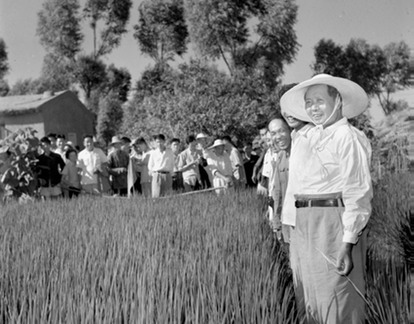The Observer, 5 September 2010
The horrors of China's Great Leap Forward are unveiled in this masterly study of the hateful plan
Frank Dikötter has written a masterly book that should be read not just by anybody interested in modern Chinese history but also by anybody concerned with the way in which a simple idea propagated by an autocratic national leader can lead a country to disaster, in this case to a degree that beggars the imagination.
The basic narrative of the great famine that hit the People's Republic around 1960 has been known outside China at least since Jasper Becker's groundbreaking 1996 account, Hungry Ghosts. Its claims were doubted by those who could not accept the sheer monstrous scale of the calamity visited on the Chinese people as a result of the Great Leap Forward launched by Mao in 1958 to propel China into the ranks of major industrial nations. But now Dikötter's painstaking research in newly opened local archives makes all too credible his estimate that the death toll reached 45 million people.
Staggering though it is, the statistical total is only part of the story that this book tells. By digging into the records, Dikötter provides a detailed litany of the degree of suffering the Great Helmsman unleashed and the inhumane manner in which his acolytes operated. Horrors pile up as he tells of the spread of collective farms and the vast projects that caused more harm than good and involved the press-ganging of millions of people into forced labour. As the pressure mounted to provide the all-powerful state with more and more output, the use of extreme violence became the norm, with starvation used as a weapon to punish those who could not keep up with the work routine demanded of them. The justice system was abolished. Brutal party cadres ran amok. "It is impossible not to beat people to death," one county leader said.
In the draconian, top-down, militaristic system that ruled China, the harsh execution of orders was a way for officials to win promotion as they were set impossible targets for everything – even for the number of executions. The inefficiency, waste and destruction were gigantic. The masses in whose name the Communist party claimed to rule were eminently disposable. From 1927 to their victory in 1949, Mao and his companions had waged ruthless warfare (against equally ruthless if less effective nationalist opponents); now the campaign was economic and the farmers and industrial workers were the fodder expected to sacrifice themselves for the cause dictated from on high. Anybody not ready to lay down their life would have it taken from them in the name of the higher good of the cause.
The book's title is somewhat misleading. Horrific as it was, with its cannibalism and people eating mud in search of sustenance, the famine generated by the Great Leap's failure and the diversion of labour from farming was only part of a saga of oppression, cruelty and lies on a gargantuan scale. Initially launched to enable China to overtake Britain in steel production, Mao's programme took on a deadly life of its own. At the apex of the system, the chairman refused to recognise reality, spoke of people eating five meals a day, insisted on maintaining food exports when his country was starving and indulged in macabre throwaway remarks such as: "When there is not enough to eat, people starve to death. It is better to let half of the people die so that the other half can eat their fill."
The depth of Dikötter's research is enhanced by the way in which he tells his terrible story. The book is extremely clearly written, avoiding the melodrama that infused some other recent broadbrush accounts of Mao's sins. He also puts the huge disaster that befell China into the context it needs – the Sino-Soviet split, Mao's ambitions for the People's Republic and the acquiescence of most of those around him until it was too late.
Finally, somebody had to confront the leader. As China descended into catastrophe, the second-ranking member of the regime, Liu Shaoqi, who had been shocked at the conditions he found when he visited his home village, forced the chairman to retreat. An effort at national reconstruction began. But Mao was not finished. Four years later, he launched the Cultural Revolution whose most prominent victim was Liu, hounded by Red Guards until he died in 1969, deprived of medicines and cremated under a false name.
The Cultural Revolution is widely remembered, the Great Leap much less so. Having gone through those two experiences, not to mention the mass purges that preceded them and the Beijing massacre of 4 June 1989, it is little wonder if the Chinese of today are set on a very different course that rejects ideology in the interests of material self-advancement.
But there is one enormous snag. The Communist party still holds that Mao was 70% good, 30% bad. The Great Helmsman's face stares out over Tiananmen Square and from the country's bank notes. If the bad things that happened under him are common knowledge, he has slipped into the time-honoured category of rulers who wished to do good but whose aims were traduced by evil subordinates.
Though some mainland historians have bravely delved into the history of the period covered in this book, the truth is still too troubling to be acknowledged openly by the current rulers of China for one simple reason: Mao is the first emperor of the regime established in 1949 and they are his heirs. Dikötter's superb book pulls another brick from the wall.

